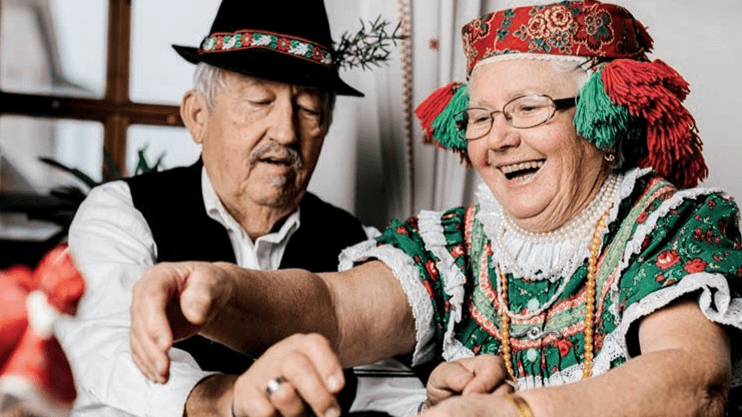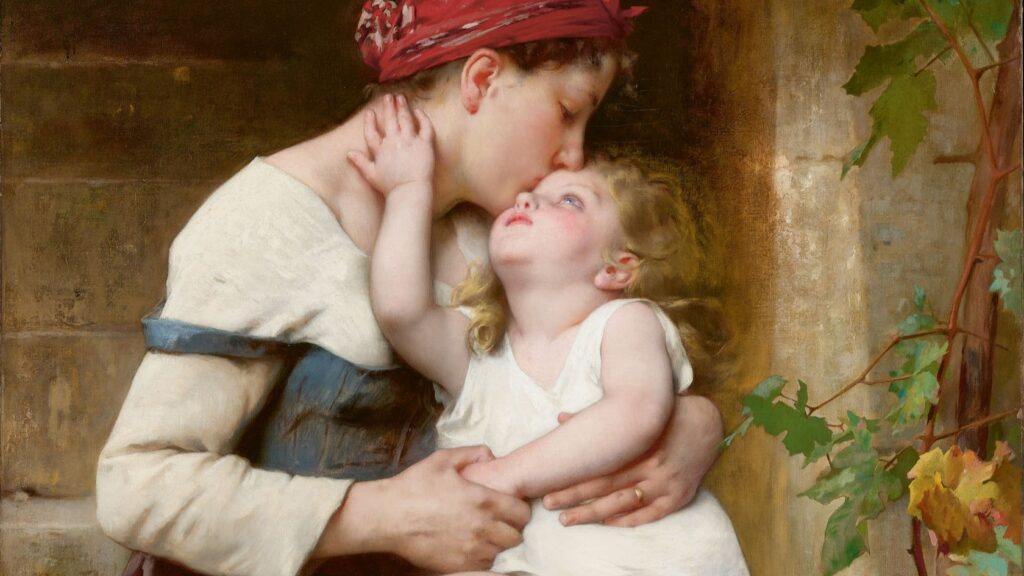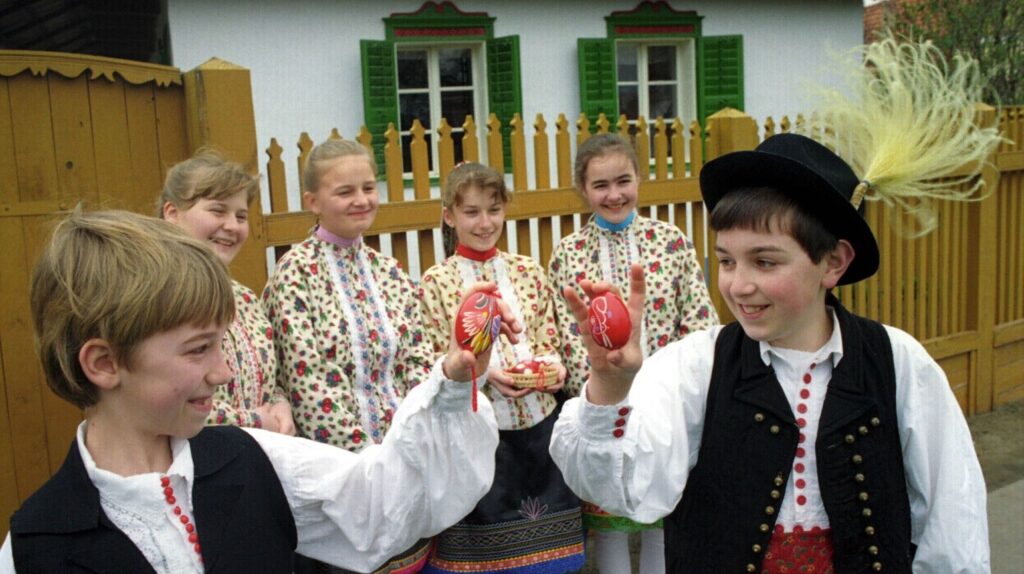Despite the cold, Tard is covered with flowers even at this time of year. Seamstresses, both young, innovative entrepreneurs returning to their hometown and those who have been sewing since childhood, bring new life and reinterpret famous matyó embroidery in the Matyodesign studio.
Once upon a time, in a land not that far away, on this side of the Great Sea, in Matyó Land, to be exact, there lived a young girl. This young girl lived in great happiness and was very much in love with her beloved, until the Devil suddenly stole her love away from her. The young maiden fell into despair, pleading with the Devil to give her back her lover. But the Devil said he would return the young man on one condition: in return, he asked for the most beautiful flowers the meadows had to offer. This would not have been a problem, had it not been the dead of winter. The young maiden walked all the land and scraped away at the icy ground, but to no avail: she did not even find a single snowdrop. But as she walked in her despair, she suddenly had an idea: she collected all the colourful thread in the village and embroidered a white apron until it was full of the most gorgeous flowers of the spring. She then took the fabric to the devil. The Devil was pleased by the colourful work and the girl’s shrewdness, and returned the young man to her.
Thanks to this embroidered apron, not only does the story have a happy ending, according to legend this is how matyó embroidery was born. And it is not only the handiwork of the girl in the story whose work has left its indelible mark on the attire of the three special villages of Mezőkövesd, Tard, and Szentistván. Although matyó embroidery was already famous at the turn of the twentieth century, the role of Jankó Bori Kis, who, as one of the most famous pattern designers, led matyó embroidery into its golden age in the first half of the century, should not be left unmentioned. Her contributions made this style of embroidery richer and more decorative, and she came up with most of the variations of the famous matyó rose.
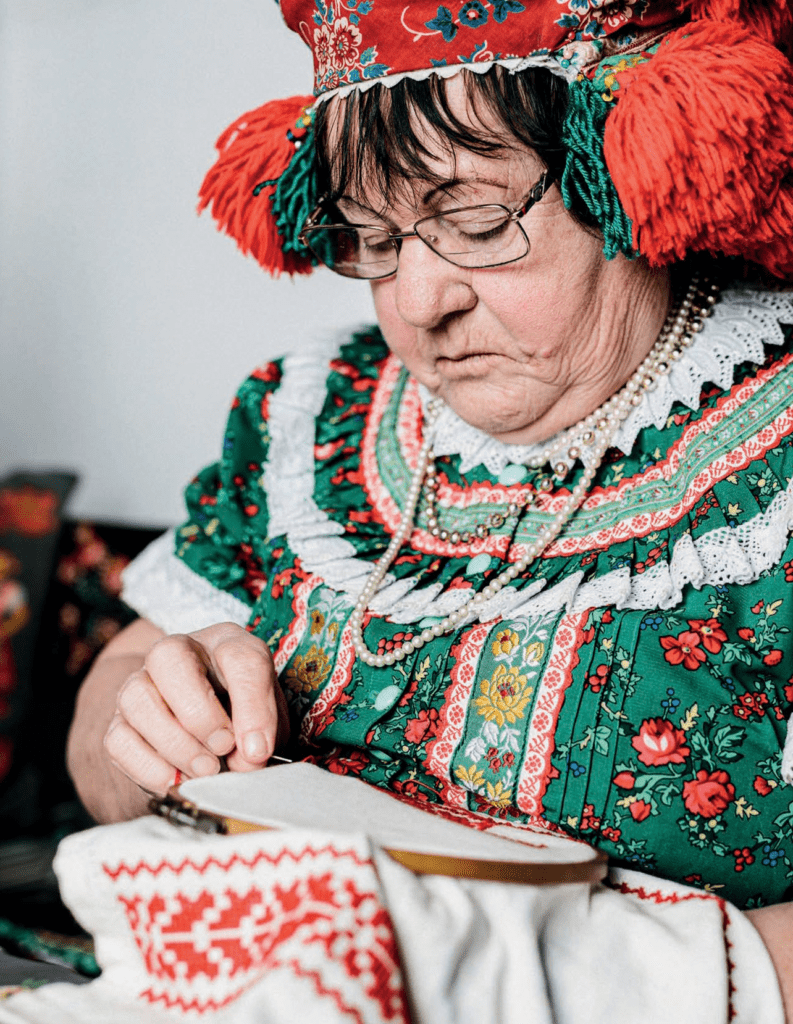
This woman in traditional costume is one of the few who still uses the traditional cross-stitching from Tard. She showed her skills to us at the tradition preservation event held in the local heritage centre. Later the slanted embroidery patterns became widely known as matyó embroidery. Matyodesign also uses the latter.
Skills passed down from mother to daughter, respect for tradition, following rules, and sometimes a spirit of modernization (sometimes a little bit more, sometimes a little bit less) – these are the ingredients that have helped matyó embroidery survive and develop. The dynamics of these effects can still be felt today, though obviously in a different manner. We notice the signs immediately when we enter Tard, a village of one thousand inhabitants neighbouring Mezőkövesd. On one side of the road stands the church with an altar-cloth that took the local women twenty five years to embroider. And even that embroidery is something quite special: the locals proudly explain that the flower motifs use a cross-stitch that is the oldest matyó technique, the one that comes from Tard, distinctively setting it apart from the other two matyó towns. Just a couple of steps away is a beautifully restored white traditional Hungarian peasant house that stands out from the rest of the buildings in the village. This is the home of Matyodesign. Across from it stands another renovated peasant house: the one owned by the founder of the brand, Rozi Váczi. She is one of the innovators mentioned above – Rozi and her team are continuing development or rethinking the slanted technique and motif system typical of Mezőkövesd to make clothing with matyó patterns that can be worn every day, that can hold their own in trendy slow fashion, and for which tourists will stand in line at expensive gift shops – at least in pandemic-free times. According to the counter on the website, the brand has already sold 66,000 hand-embroidered products.

‘To me, Tard was always a symbol of freedom’
How does one come up with the idea of giving modern forms to matyó motifs that are hundreds of years old and that we most often see only on overly adorned, low-quality tablecloths around popular tourist destinations, and to sell them sewn on T-shirts, ponchos, pullovers, and dresses? We asked the founder of the brand, who takes off her camouflaged jacket as she passes from the cold outside to one of the building’s rooms filled with colourful clothes, to show us the blue embroidered top she is wearing underneath it.
It turns out we have to go back to the 1980s for the answer. That is when Rozi’s parents, two young teachers at the time, decided to try their luck in a small village. According to the family legend, they had already toured eleven villages when they finally came to the outskirts of Tard. Here, they hitched a ride on a horse-drawn cart which took them to the church. Upon entering, the husband asked the bell ringer whether he could try the organ. The lady said yes, and he walked up to the gallery. ‘When he started playing, they both knew this would be their new home,’ Rozi relates the story she heard from her parents. However, she has few memories of life in Tard. She was just five years old when the family moved to Budapest, though they returned to the village for vacations. ‘I remember Tard was always a symbol of freedom for me,’ she recalls nostalgically, then goes on to explain: ‘For me, the matyó culture was so natural that it took my leaving to realize, as a grown up, just what treasures are hidden here, and the beauty and energy in them.’ This realization came at the age of thirty, when, returning to the village following the birth of her first child, she was thinking about what to get for her daughter’s father for his birthday. ‘That’s when I thought of matyó embroidery. I asked dear old Teri néni, my little brother’s nanny, to embroider a pretty motif on a T-shirt. When she was finished, I was very enthusiastic, I wanted one for myself, and a lot of friends and colleagues in Budapest had the same reaction when they saw the result. That’s where the idea came from.’ The experience and attitude gained in Budapest, together with the demand existing there, and the connection with the women of the village, who still have the know-how, made it possible to launch the brand. The first T-shirt turned into a company step by step. In the beginning, Rozi took some items of clothing from her wardrobe in Budapest to Tard to have them embroidered, and then returned with the finished products. ‘At the time, I had no idea that I could make a living doing this. I thought I would just act as mediator between the demand in Budapest and the know-how in Tard, helping to give back to the women a little of what I had received from them from the time of my birth. The end result is truly amazing! Many of us have worked a lot to get to where we are now. We grew and developed together.’
Today, twenty-seven women in the area do embroidery for Matyodesign. Most of the women are elderly, and most take the work home once a week and return with the finished products the next. The payment they receive goes a long way to supplementing their pensions. Matyodesign’s offices are also in Tard, which also provides job opportunities for locals. And, as Rozi says, the question of whether she gives work to a seamstress in Budapest or to local women is an important one. The fact that the work is done in the village also adds to its authenticity. ‘Not to mention the fact that the people here do beautiful work. I see the strength of local women: they are never idle. It is nice to bring a little light to an area like this, because it draws people in. And if they come, we can move forward together, to help the light draw in even more people,’ the head of the company paints a picturesque image using an apt metaphor. Recently, she has gotten an even better glimpse of the lives of the locals, as she too has moved to Tard during the epidemic, and has devoted even more energy to planning the future of the brand. ‘I still have to learn to pick up the rhythm of the village. But there is a future here that isn’t present in Budapest, and there are a multitude of tasks,’ she says.
One of these tasks is to find the next generation. Many of the women doing the embroidery have been working for the company for more than ten years, and they are not getting any younger. And even if the currently middle-aged women can embroider, they are finding it increasingly hard to teach the technique to their children. ‘Maybe more people will pick up the needle and thread because of the opportunities we offer, even if they don’t do it for the sake of preserving traditions. And even so, it will do the matyó culture good,’ declares Rozi hopefully.
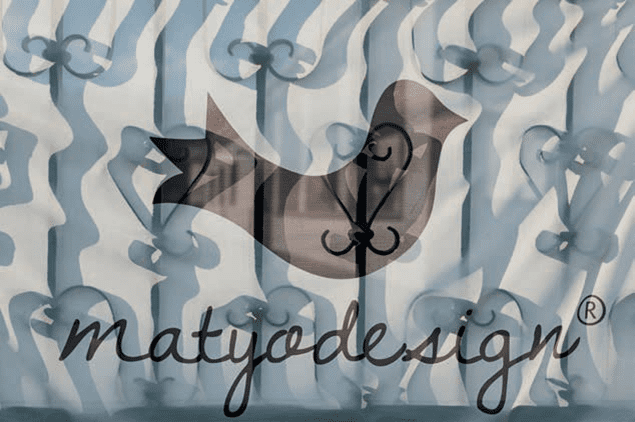
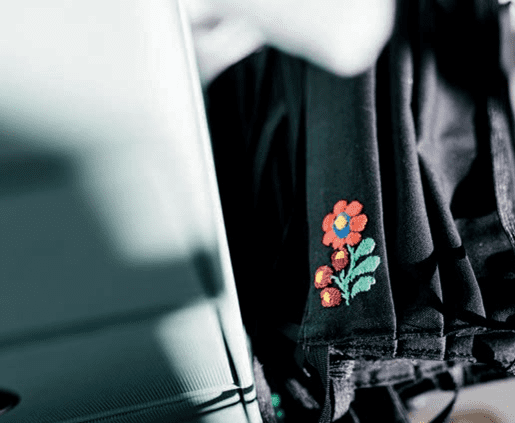
Matyodesign tried to make up for the revenue lost during the coronavirus epidemic by making masks. The motifs used have been named the Flowers of Hope, trusting that the hardships would soon be over.
This very process comes to life in front of our eyes when we walk into another room in the peasant house, where Marika and her daughter Barbara are working together to make masks – which are in greatest demand in the epidemic. While they show us the sewing process, from applying the pattern to embroidering and ending with packaging, I learn that Marika started working for Matyodesign nine years ago and has been even more involved in the process since she retired. She has been embroidering since she was young: when she married her husband from the village of Cserépváralja, her mother-in-law showed her the tricks of the trade. At the time, there were scores of seamstresses in the area, and most of the women worked for them, so embroidering was natural. However, there are few people with the necessary skills today. ‘I never told anyone in school that I can do embroidery. They would have made fun of me. If I told someone that I made my sweater with the pretty flower design myself, they looked at me strangely,’ says the twenty-nine-year-old Barbara, confirming the generation gap. She has been working here full-time for just over a year. Contrary to many of her peers, she learned the technique from her mother and, since there are not many people to talk to in the village and even leaving the house has been difficult lately, they now embroider together. ‘We usually work until ten thirty at night. We like the work, and it’s a nice feeling that we have something to do that even relaxes us,’ she adds, revealing just how much work each item requires. ‘It takes me two afternoons to embroider a T-shirt. In the same amount of time, I can finish two masks. Mother is faster, she can decorate two ponchos in just half a day.’
Involving younger generations is beneficial to the brand, and not only by securing a future. Although Matyodesign is based on matyó patterns, they are bravely adding to the design language – just as Jankó Bori had done in her time. This can extend to the use of non-traditional colours and the inclusion of unexpected elements like a hummingbird flitting between matyó flowers. The younger generation embrace these changes more easily than the older generation, raised on traditional colours and motifs. ‘We work with different colours, simply because a shade of ochre better matches a yellow poncho. This is more difficult for people who are accustomed to traditions, even though these are beautiful too,’ explains Barbara. Marika then pulls out a sweater with a traditional embroidered pattern to show us just what traditional means. ‘There are strict rules. Traditionally, we use five colours, and each has its own meaning. The matyó rose always has three colours: red or lilac on the outside, which can be touched by blue only. Heading towards the centre of the flower, the blue is followed by yellow and either lilac or purple. The real matyó flowers are the rose, the tulip, the daisy, and the forget-me-not.’
Of course, being born in Tard, Rozi knows this, but as she says, ‘We deal with the matyó patterns with deep knowledge, reverence, and respect. Because that is how we approach it, we can dare to be flexible. Our mission is to preserve this unbelievably valuable tradition. And not just preserve it, but include it in clothing and in a framework that lets it be understood, used, and worn with the proper respect in today’s world.’
Be it traditional or novel colours, or techniques from Tard or Mezőkövesd, using and wearing these motifs can only do good. We should all have a T-shirt, a pullover, or an apron with matyó embroidery, or at least a mask with flower patterns to protect our loved ones.
Rozi Váczi recently established a new branch of her company, Matyodesign Tour, which allows visitors to participate in the lives of local women for a day. They can try on traditional clothing and catch a glimpse of the secrets of sewing and making pasta.
Read more:

